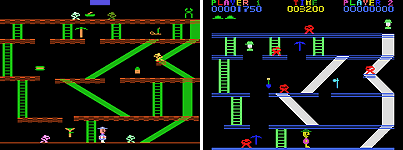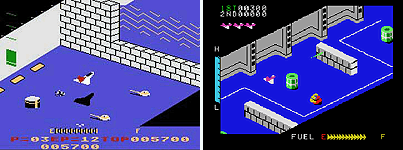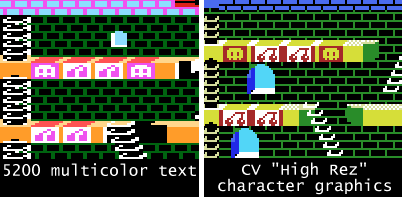|
COLECOVISION VS. ATARI 5200: HARDWARE COMPARISON - Back to page 1
 Miner 2049er for 5200 (left) and Colecovision (right)
Trying to decide which machine has "better" graphics a prime
example of how hairy these comparisons can get. The CV has
four graphic modes, the 5200 has something on the order of
17 (14 different ANTIC modes, and 3 additional variations on
mode F handled by the television adapter chip). Rather than
listing them all, the most similar modes will be compared. (NOTE: In the following text you will see graphics mode
statistics like 160x192x4 or 256x192x16. For those not
familiar with this type on notation, the first number is the
screen's horizontal resolution (rez), the second the
vertical rez, with the third number representing the number
of colors in that mode. Rez can refer to total pixels or
characters, but usually refers to pixels unless otherwise
indicated. Total screen colors includes colors displayable
in the graphics area, and does not include the ability to
set the screen border colors to something else.)
The CV's and the 5200's text modes are very similar. Each
consists of a grid of 8x8 pixel characters arranged in 40-
columns by 24 rows. Only two colors can be used, one for the
background color, the other for the pixels defining the
characters. On the 5200 these two colors must be different
luminances of the same hue (such as dark blue and light
blue), where on the CV they can be any two colors. The
pixels of the characters can be redefined to make special
fonts or graphical elements, but the 5200 character set is
only 128 characters (256, actually, but the second 128
characters are simply "inverse" images of the first 128),
compared to the CV's 256.
Advantage: Colecovision.
2. Multicolored bitmap mode
The CV contains only one mode in which pixels can be plotted
to the screen without redefining the pixels of characters.
This mode, illustrated by the Smurfs Paint 'n Play cart,
allows all of the CV's 16 colors to be used at once and
without any limitation on their arrangement. However, the
resolution is quite low, a paltry 64 x 48 pixels for the
entire screen! The 5200, by contrast, features numerous
bitmap modes, however, the closest match to the CV's
bitmapped mode are the rarely used "GTIA" modes, of which
there are three, all with a resolution of 80x192 pixels. In
one, the hardware can display all 16 hues, but all at a
single luminance. In another, it displays pixels in 16
different luminaces of a single hue (such as a range of
black through gray to white). In the final mode, it can
display nine different colors of any hue and luminance. The
5200 has the edge in terms of both resolution and colors.
3. Multicolor character modes
 Zaxxon for 5200 (left) and Colecovision (right) A little background here for those new to this venerable technology. Character graphics were commonly used to generate screens on many early consoles and home computers. In fact, most Colecovision and many 5200 games use character graphics for their displays. The reason you don't see a screen full of text, numbers and symbols is because the pixels composing the characters have been redrawn to represent all or part of an object, character, background element, etc. In such a mode the graphics are created by treating the screen like a puzzle with square pieces, each piece -- a "redefined character" -- containing a different bit of a picture. Put them together in the right ways and you have game screens. Redefined characters are used for a number of reasons, not the least of which being that -- in most cases -- they are more memory efficient than and faster to plot to the screen than bitmapped graphics. For example, while it takes 2K to store the patterns for 256 characters, it takes only 960 bytes (just under 1K) of screen memory to store a 40x24x2 character screen, whereas it takes 7,680 bytes (8 times the space) to store a 320x200x2 bitmapped display. Thus, to draw and redraw a text screen takes, in this example, 1/8th the screen memory and time required to do the same in the bitmapped mode (the character data is stored elsewhere). Both the 5200 and CV feature multicolor character modes, in which the usual text characters can contain more than just off and on pixels (background color and character color). However, these modes are different in their makeup and limitations. The CV's multicolor text mode is what most games for the system use. It consists of a 32x24 grid of characters and uses a set of 256 characters that can be redefined. The way color comes in is a little weird. Each horizontal cluster of 8 characters can contain any two colors, i.e. characters 0-7 have one pair of colors, while 8-15 have another, etc. The 5200 has two multicolor character modes, which differ only in the size of the characters. The one closest to the CV's is a little hairy to explain. It is a 40x24 grid of characters out of a set of 128 characters. The screen displays four colors, any and all of which can appear in any character. Each character consists of a 4x8 grid of pixels (the pixels are twice as wide as they are tall). Like the normal text mode (see above) a second 128 characters are available, however, instead of being "inverse" (on and off pixels reversed) versions of the first 128 , they are identical except that whichever pixels of a character are set to the fourth color appear as a different (fifth) color. These modes are so different that they are difficult to compare. The CV's advantage is resolution: its multi-color characters are 8x8 pixels, whereas the 5200's are 4x8. The CV also can display more total colors on the screen than the 5200 in their multicolor text modes (15 opposed to five), but the former is limited to two colors per every eight characters. The 5200 has more characters per row (40 compared to 32) for a larger screen area, and each character can contain four colors, not two. Confused? Not surprising. To summarize, the CV has better resolution per-character, number of totally unique characters, and total colors on screen a once, whereas the 5200 has a per-character color advantage and more characters per screen (960 to 768). However, the CV's limit of 2 colors for every 8 characters undermines its advantages, so... Advantage: 52004. An Additional CV Mode The CV contains one additional mode for which there is no direct parallel on the 5200. It is what is sometimes referred to as "hi-rez GFX" mode, and is a multicolor character mode that's behaves something like a bitmap. As with multicolor character mode, it consists of a 32 x 24 grid of characters, and each character is 8x8 pixels, but that's as far as the similarity goes. Instead of setting two colors for each set of 8 characters in a row, each character may contain any/all of the CV's 16 colors, and instead of 256 characters which are plotted to create a screen, in this mode the screen consists of 768 totally distinct characters...fully three times as many as normal.  Character graphics compared, demonstating the finer pixel width on the Coleco (Mr. Do's Castle)
Sounds wonderful? Well, there are some limitations. First, while each character can contain any or all of the CV's 16 colors, only two may appear in a given row of each character. Second, since each of the screen's characters are totally unique, redrawing the screen is not as simple as telling the machine to plot character A to a given location (as with multicolor text mode). To change a character means having to directly rewrite its character data in video memory. The latter is a far more processor intensive task than normal, thus large-scale changes to the screen are slower and more difficult to accomplish. As the 5200 has no mode similar to this, it's tough to compare. However, in the crudest summary one can say the CV hi-rez mode is a fairly static display of 256x192x15, whereas the closest Atari modes would be the multicolor character mode's display of 160x192x5 colors, or its GTIA modes of 80x192x16. One, lower rez and fewer colors, the other, even lower rez and an equal number of colors. Advantage: Colecovision.
|
